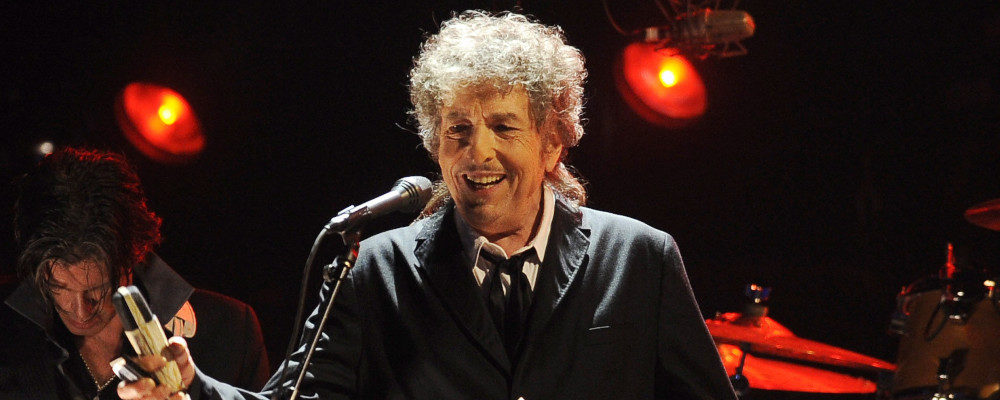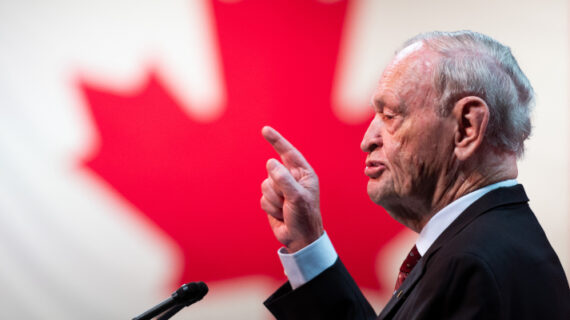In an interview on the release of his 2004 autobiography, Bob Dylan was asked whether it was true that he’d written Blowin’ In The Wind in 10 minutes.
“Probably,” Dylan responded. And where had the inspiration come from? “It just came,” Dylan continued dismissively. “It came from, right out of that wellspring of creativity, I would think.”
Dylan never thought the song, which quickly became the anthem of the civil rights movement, was one of his best. A case can be made that it’s the most important song of the post-War era, encapsulating the ’60s idealism and youth culture that remains influential. It’s also one of the most recorded popular songs — by Peter, Paul and Mary and Stevie Wonder, famously, but also by many who swung and missed on it, like Elvis Presley and Marlene Dietrich.
MORE SIGNAL. LESS NOISE. THE HUB NEWSLETTER.
Dylan’s view was summed up in his response to George Harrison when the former Beatle asked him a very long decade later to play it at the Concert for Bangladesh. Dylan, in turn, asked Harrison — they’d been recording together — whether he’d sing I Want To Hold Your Hand. (Dylan, in the end, did play it that night.)
Blowin’ In the Wind was mostly written on the afternoon of April 16, 1962. Dylan wrote the first verse (“How many roads …) and what became the third verse (“How many times …) as fellow folkie David Cohen strummed chords under Dylan’s guidance. The second verse (“How many years …”) was added days later. (Cohen, who performed as David Blue, is possibly most famous as the man sitting cross-legged on the cover of Dylan and The Band’s 1975 album The Basement Tapes.)
The song was “hot off the pencil,” in the words of the Greenwich Village coffeehouse MC who introduced it that night to a crowd that sat stunned after hearing it, then erupted.
But it was also a century old. Dylan based it on a Civil War-era song called No More Auction Block, which likely originated with former slaves who escaped to Canada on the Underground Railroad. Dylan had heard the song days earlier from Delores Dixon, the only African-American member of the New World Singers.
Blowin’ In The Wind — Peter, Paul and Mary sang it at the 1963 march where Martin Luther King Jr. gave his “I Have a Dream” speech (and Dylan sang two other songs) — might be considered today, then, to be cultural appropriation.
No one thought like that then. Dylan sang No More Auction Block often in Greenwich Village in 1962 and into 1963. He’d become attuned to black music, Little Richard especially, as a teenager in northern Minnesota by staying up late to listen to the crackling sound of a Louisiana radio station. Blowin’ In the Wind caused Mavis Staples to ask in amazement how a 20-year-old white boy could capture so perfectly the indignities and aspirations of black people.
“… there is a long history of artists taking on identities that aren’t theirs, as well as building their artistic output on the shoulders of others.”
On Sunday, a livestream concert by Dylan, who turned 80 on May 24, is set to premiere. Titled Shadow Kingdom, an Internet clip suggests he’ll focus on his early songs, possibly including Blowin’ In The Wind. It was an encore staple during his so-called Never Ending Tour, in which he played an average of 100 dates a year for three decades, until the pandemic. The concert also might be considered a bookend as the pandemic winds down (fingers crossed), opposite release at the beginning of the pandemic in spring, 2020 of his 39th studio album, Rough and Rowdy Ways.
Meanwhile, New York City plans to mark its reopening with “Central Park Comeback” on August 21, including half-a-dozen star performances, culminating with Paul Simon and Bruce Springsteen. Simon will be 80 in October; Springsteen is just 71.
Simon and Springsteen, in their own ways, are magpies and shape shifters too. In his hit show Springsteen on Broadway, which reopened in late June, Springsteen takes note of topics that have dominated his 50-year songwriting career. He can hardly claim that descriptions of working-class anxiety and the draw of the open road are autobiographical, he says, though he wasn’t raised in a comfortable home.
“I’ve never done any hard labour. I’ve never worked nine-to-five. I’ve never worked five days a week until right now. I don’t like it. I’ve never seen the inside of a factory and yet it’s all I’ve ever written about. Standing before you is a man who has become wildly and absurdly successful writing about something of which he has had absolutely no personal experience. I made it all up. That’s how good I am.”
Simon, for his part, was responsible for one of the biggest artistic leaps by a mainstream American artist during the heyday of pop. He was still a star in the mid-80s but seemingly without inspiration or a path forward until he went to South Africa and recorded the immensely popular album Graceland. This was during apartheid, and he was criticized widely for engaging with local artists instead of boycotting the country and regime. But he also gave unprecedented attention to African music, then virtually unknown in the West, and helped to launch the musical genre known as Worldbeat.
As concert halls reopen, there is heightened attention to diversity in programming, just as there is in terms of workforce. The opportunity that comes from casting a wider net was brought home forcefully in a big multicultural city like Toronto some years ago, during the Pan/Parapan American Games, when nightly concerts drew 20,000 fans for artists well beyond the Can/Am mainstream.
Likewise, Canadian music venues should be thinking more about nurturing homegrown talent, especially from Indigenous, black and racialized communities. When venerable Massey Hall reopens in late fall, the complex also will include three smaller venues with capacities in the hundreds; two of them in a new building attached to the 1894 hall, which has been renovated and updated.
Those are perfect settings to give greater effect to cultural objectives that go beyond just putting on shows, and are written right into the founding documents of the non-profit Corporation of Massey Hall & Roy Thomson Hall, as one key example: “to advance the development of the performing arts in Canada (and) to provide opportunities for Canadian artistic talent.”
“… promotion of a diverse range of artists is not the same thing as insisting that artists stay in their lanes based on origins and background.”
Massey Hall will reopen with three concerts by Gordon Lightfoot, as it should. No one is more identified with the hall than Lightfoot. But he, Buffy Sainte-Marie, Bruce Cockburn and Mavis Staples too — all booked for the first six months of reopening — are hardly the future of popular music.
At the same time, the increased importance put on promotion of a diverse range of artists is not the same thing as insisting that artists stay in their lanes based on origins and background.
The accusation of appropriation has credence when artists claim identity with a victimized minority group that is not theirs, or only vaguely so. This has been most evident regarding Indigenous identity, as recognition grows of the impacts of Canada’s colonialist history.
But, here too, there is a long history of artists taking on identities that aren’t theirs, as well as building their artistic output on the shoulders of others.
The line is sometimes clear, but often fuzzy.
Back to Dylan, for example. Blowin’ In The Wind was of a pattern. Many of Dylan’s early songs were based on traditional songs. In his autobiography, published posthumously, folksinger Dave Van Ronk tells of a sentimental ballad he’d learned from his grandmother called The Chimes of Trinity. “He (Dylan) made me sing it for him a few times until he had the gist of it, then reworked it into Chimes of Freedom. Her version was better.”
(Dylan wrote the song, incidentally, on paper from the long-gone Waldorf Astoria Hotel in Toronto, as is displayed on the website of the Bob Dylan Archive in Tulsa, Oklahoma.)
Furthermore, Dylan’s very persona when he arrived in New York City in January 1961 was a confection. He was a middle-class Jewish kid from Hibbing, Minn., which might then have been America’s wealthiest blue-collar town, but headed into decline. His family owned a string of movie theatres. (One was named after Dylan’s great-grandmother, Lybba, and closed in 1982. Dylan’s son Jesse, a Hollywood producer, launched a non-profit called Lybba 25 years later.)
Dylan claimed he was a Sioux Indian from New Mexico and showed off how to speak in “Indian sign language,” Van Ronk recalled. Dylan told the New York Times writer whose glowing review got him a Columbia Records contract — unheard of for a folksinger — that he’d survived his first weeks in the big city as a male prostitute.
Dylan styled himself after Woody Guthrie right down to his hero’s mannerisms, including on stage. It was entirely inauthentic but within 15 months he’d written Blowin’ In the Wind and in another 18 months he’d play to a Carnegie Hall audience which knew every word of his songs.
Van Ronk notes that the Greenwich Village circle figured Dylan was putting them on but they didn’t much care. Everyone there then was doing something like it. Dylan’s secret didn’t get exposed until after he learned that Ramblin’ Jack Elliott, who’d based his persona, songs and performing style on Guthrie, was actually the son and grandson of Jewish doctors from Long Island. Van Ronk, who was at the table when it happened, relates that Dylan literally fell out of his chair in amazement at the news.
(Ramblin’ Jack’s parents weren’t pleased at his career choice but sat up front at a Greenwich Village show after he’d been away for a time out West. Between songs, his mother said in a stage whisper: “Look at those fingers … Such a surgeon he could have been!”)
Of course, Dylan was able to construct a new identity, such that it became his real identity, because he was what amounted to an invisible minority. Asked why he changed his name from Zimmerman to Dylan, he told a friend in 1971 that it was to avoid anti-Semitism. But years later, he said simply: “You call yourself what you want to call yourself. This is the land of the free.” (Ethel Zimmermann joked that she changed her name to Merman because she feared that her family name in lights would bake the audience.)
Dylan based much of his late career output on early 20th-century blues, mid-century country and other musical strains that were considered then, and sometimes now, to be low-brow fare. It’s been called his archaic period but, really, he was more archaic when he modelled A Hard Rain’s a-Gonna Fall on the 17th-century Anglo-Scottish ballad Lord Randal.
Some of his best later songs pay homage to black artists — Blind Willie McTell, High Water (For Charley Patton), Goodbye Jimmy Reed — just as many of his early songs protested the injustices faced by black America, like The Death of Emmett Till, The Lonesome Death of Hattie Carroll, Hurricane.
In so doing, he’s raised attention about prejudice as well as highlighted artists who deserve to be better known. He’s also done very well doing so. He sold his back catalogue of more than 600 songs to Universal Music last December for more than $300 million USD.
As he begins his eighth decade as a performer, his unrivalled career might stand as something of an exemplar of the complexities of concepts like artistic licence, cultural appropriation and, indeed, modern music.
Now, let’s see what Sunday brings.




